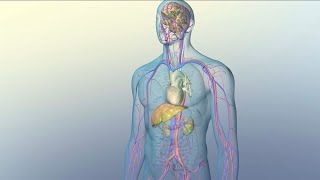![]()
MEDICAL ANIMATION TRANSCRIPT: Distribution is the process by which a medication is carried to its target tissue or site of action with the goal of causing a therapeutic response. This process follows medication absorption and precedes medication metabolism. Medication is first carried to highly vascularized tissues including the liver, heart, kidneys, and brain. Then medication is widely circulated within the body, reaching areas of less extensive blood supply such as skin, muscle, and fat. Medication then accumulates in the fat and in poorly vascularized tissues like bone, especially if the medication is lipophilic or strongly attracted to lipids. In the blood, some medication molecules bind to plasma proteins to which they are attracted. In this bound state, medication molecules are unable to produce a pharmacological effect. In bound and unbound form, the medication flows through the arteries and into capillaries. Capillaries carry the medication close to the tissue’s cells, where hydrostatic pressure drives molecules between the capillary endothelial cells into the interstitial space. Some protein-bound macromolecules are too large to pass through the vessel walls, so they never reach the target tissue. Unbound or free molecules do reach the target tissue by exiting the bloodstream between the loss junctions in the capillary endothelium into the interstitial space to interact with the tissue cells. Some molecules bind to the cells while others remain in the extracellular fluid. The interaction of the unbound medication with the target tissue results in a therapeutic response. There are many factors that affect distribution. For example, the effect of membrane permeability on distribution can be demonstrated in the brain. The brain’s capillaries are impermeable to the majority of medications due to the blood-brain barrier, a membrane that blocks the entrance of both toxic and therapeutic substances into brain tissues. Some medications penetrate the blood-brain barrier based on features like low polarity and high solubility in lipids. Fat-soluble molecules cross cell membranes faster than water-soluble molecules due to the lipophilic nature and phospholipid composition of the cellular membrane. Factors such as body fat percentage and disease also affect medication distribution. Fat deposits retain lipid-soluble unionized medication and release the molecules over time. Thus, obese patients may experience prolonged pharmacologic effects. Inflammation, disease, and injuries such as burns can alter protein levels and thus medication binding, increasing capillary permeability and uptake in cells and tissues. As a complication of kidney disease, albumin cannot bind medications effectively, resulting in a low percentage of protein-bound medication. These shifts result in high levels of free medications circulating throughout the body.
#MedicationDistribution #pharmacology #DrugTherapies
ANM10008
